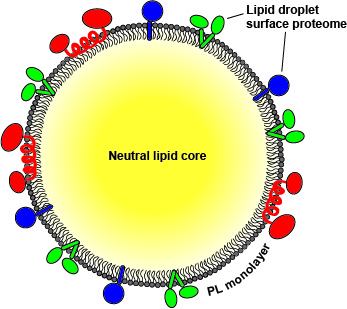Lipid droplets are fat storage organelles that are found in virtually all cells of our body. They harbor most of the cells metabolic energy as well as building blocks for synthesis of crucial structural lipids required for formation of the cellular membranes. In addition, lipid droplets have active key roles in metabolism, particularly in lipid metabolism. Therefore, it is not surprising that they are implicated in numerous human diseases, including obesity, diabetes, fatty liver, atherosclerosis, and lipodystrophy.
Lipid droplets have a unique architecture, comprising a core compartment consisting of neutral fat and a surrounding phospholipid monolayer shell that harbors the lipid droplet surface proteins, particularly numerous lipid metabolism enzymes.

Figure 1: Lipid droplets have a unique architecture. Lipid droplets consist of a central core composed of neutral fats that is shielded towards the aqueous cytosol by a phospholipid monolayer. The lipid droplet proteome comprises diverse proteins that are attached to the surface of the organelle.
In order to fulfill their diverse functions, lipid droplets need to constantly exchange material and information with the other cellular organelles. However, how this communication works has for a long time been enigmatic, because the special architecture of lipid droplets with their surrounding phospholipid monolayer represents an obstacle for material exchange via bilayer-bounded vesicles (Schuldiner & Bohnert, 2017, BBA).
A different form of interorganellar communication is mediated by so-called contact sites, structures in which two organelles are physically attached to each other via proteinaceous tethers (Eisenberg-Bord et al. & Bohnert, 2016, Dev. Cell; Bohnert & Schuldiner, 2018, Nat. Rev. Mol. Cell Biol.). We find that lipid droplets are heavily engaged in contact sites, indicating that contact site-based mechanisms mediate communication of lipid droplets with most, maybe all other organelles. Intriguingly, we have recently discovered that lipid droplets that are spatially confined to particular partner organelles develop a unique surface proteome, pointing towards a link between contact site formation and organelle specialization (Eisenberg-Bord et al. & Bohnert, 2018, J. Cell Biol.).
In our lab, we are using robotic high-throughput screening approaches combined with in-depth biochemical and microscopic mechanistic analyses in order to unravel the molecular basis of lipid droplet communication. Key questions that we are addressing are:
- Which factors mediate formation and function of contact sites between lipid droplets and the other organelles?
- Which types of molecules are transferred across the lipid droplet contact sites?
- How do alterations in lipid droplet communication affect cellular homeostasis and ultimately human health?
Join us!
The Bohnert Lab is a recently established group, and we are currently actively recruiting! If you are interested in joining our lab as a graduate student or postdoc, please email Maria directly at bohnertm(at)uni-muenster.de with a statement of research interests, your CV, and contact information for references.
We also always have a number of research projects available for undergraduate students (master thesis, bachelor thesis, lab rotations).

